On Tuesday Oct. 3, a group of Fort Lewis College students and faculty came together for the FLC Opportunities for Healing through Reconciliation Efforts event, held in the Center for Indigenous Research of Culture and Language to discuss a very troubling yet important topic: the release of History Colorado and FLC’s “Federal Indian Boarding Schools in Colorado, 1880-1920” report.
The report brought to light evidence of rampant physical abuse and cultural violence against Native Americans at the Fort Lewis Indian Boarding School, the predecessor to Fort Lewis College.
That history of abuse has been well-documented through the years. But the most shocking part of the report came with archaeological findings of a graveyard at the site of the original Fort Lewis, located outside modern-day Hesperus, Colorado, where state archaeologists and tribal members believe the bodies of 31 students from eight different Indigenous tribes were buried, according to the report.
The Native American Indian Studies department strategically organized the CIRCL Space gathering around providing support and open dialogue on the impact of the History Colorado report, according to Heather Shotton, a Wichita, Kiowa and Cheyenne Native from Oklahoma and Vice President of Diversity Affairs at FLC.
Chair and Associate Professor of Native American Indigenous Studies, Dr. Majel Boxer, sat at the head of the semicircle of chairs that seated those in attendance.
Boxer introduced herself and warned those in attendance of the difficulty of what was about to be discussed. She informed everyone of the tissue boxes and therapeutic chocolate made readily available, both of which were heavily utilized before the end of the meeting. Along with Boxer, representatives from FLC’s Native American Indigenous studies, sociology department and Sexual Assault Services Organization were present—members of the FLC community who could provide support for students as the dark topics in the report were covered.
Many of the Indigenous students in attendance introduced themselves in their tribal language—the same languages that federal Indian boarding schools, like Fort Lewis, once punished Native students for speaking. Some were adorned in traditional bright and shiny colored ribbon skirts and beaded jewelry unique to an array of tribes from across the country.
The number of students who took part in the dialogue fluctuated throughout the event. Just next door, a Diné—also known as Navajo—language class was taking place, and many students joined the almost four-hour meeting after their class concluded.
Members of the faculty and students took turns reading parts of the dense 140 page report, detailing the brutality, cruelty and intergenerational trauma the Fort Lewis Indian Boarding School was responsible for.
This particular event organized by NAIS shows that there is a caring community available to students on campus. Relying on a strong and caring community is a tactic that is nothing new to Native Americans. In the weeks following the release of the History Colorado report, that community came together again in events like the CIRCL Space gathering.
They came together to acknowledge that the scars of the past are deep, and still painful. And while they came together to grieve, they also gathered to understand how to move forward with this new understanding of the past. FLC, which was once part of a system meant to destroy Native American culture, has begun the long process of taking responsibility for its dark past.
Part I: The Report
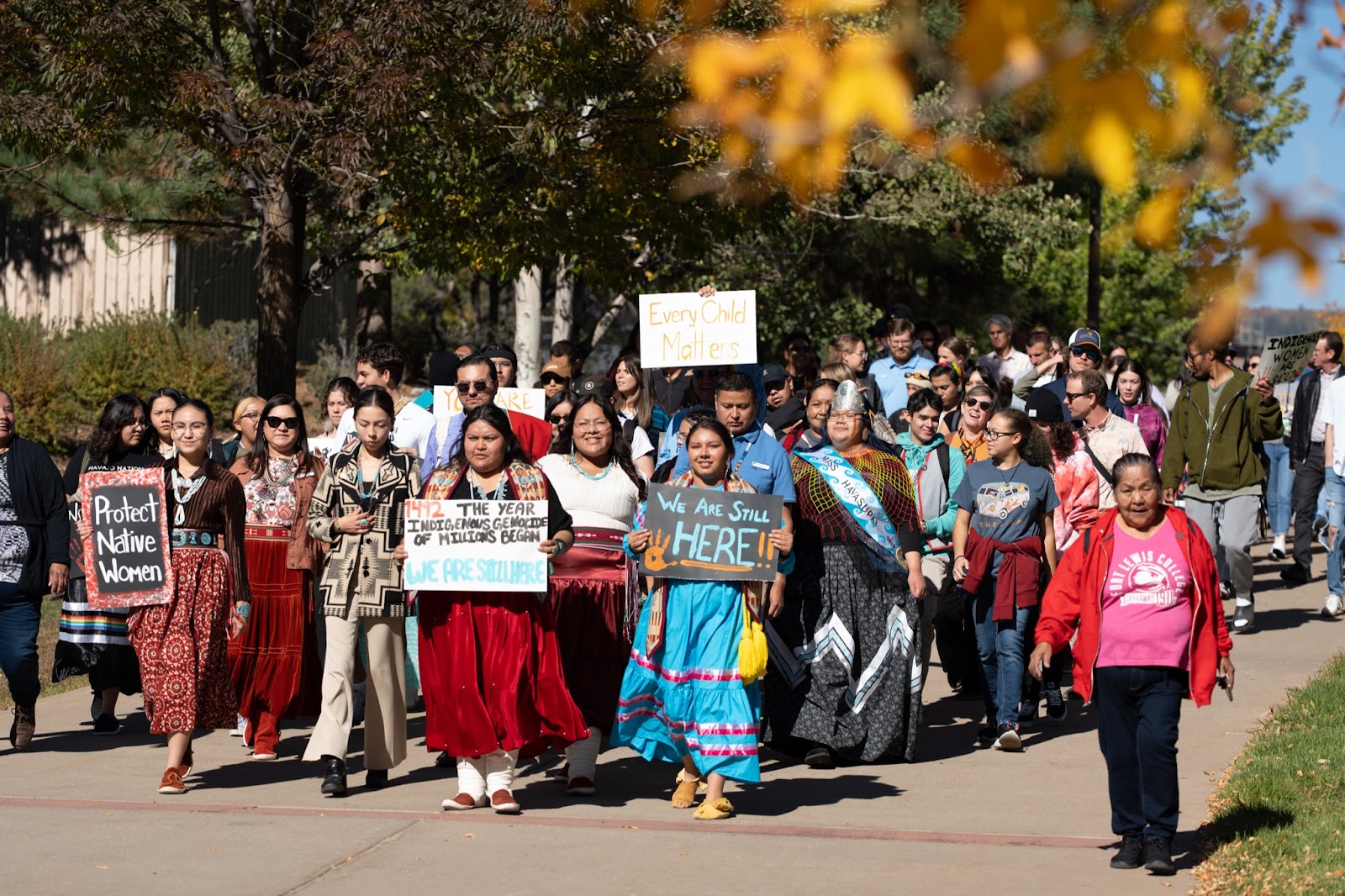
Students at the Fort Lewis College Indigenous Peoples’ Day Indigenous Blessing and Solidarity Walk on Oct. 9. Photo by Fort Lewis College.
The roots of the 2023 History Colorado Report can be traced back to 2019 when, Dr. Joslynn Lee, Assistant Professor of Chemistry at FLC, sent an email to President Tom Stritikus about a set of plaques ordaining the campus clock tower. The plaques, which members of the FLC community walked by every day, portrayed an inaccurate and insensitive history of the Fort Lewis Indian Boarding School.
“There was the initial 2019 discussion with the president, and then the history committee was formed,” she said. “So, all of that provoked, then, the discussion of ‘how do we get reconciliation not just here but at the state level.’ I wasn’t involved in those talks, but got to give guidance on what works for our campus community. Not just me, but there was our whole group of Indigenous Native faculty and also community members from the college. The New York Times came and interviewed a lot of people, and really focused on Southern Ute, or some of the history that came out in 2021. So that, I think, got the state of Colorado and then the college president to talk about ‘what do we do next’ and that’s when the money sort of focused on the ‘what actually happened’ at the Old Fort.”
This culminated in a 2021 ceremony in which the plaques were removed, correcting the misleading portrayal of FLC’s history. To Lee, this was an example of how institutions like FLC can reconcile its past as a former Indian boarding school, she said.
“Dr. Joslynn Lee in chemistry, sent me an email saying ‘I walk by these panels every day,’” said Tom Stritikus, president of FLC. “‘These panels portray my experience of my great grandfather and my families in a disrespectful and disingenuous way.’ And she was 100% right.”
The FLC history committee was formed in fall, 2019, which consisted of faculty, students and staff that sought to take an honest look at FLC’s history. But then came the COVID-19 Pandemic, the murder of George Floyd and the discovery of unmarked graves at Canada’s Marieval Indian Residential School, sparking wide-spread social upheaval and calls to recognize the racist history of the Americas, like that of FLC, Stritikus said. .
“That work started, and it ended in the removal of the panels that were disrespectful and disingenuous. It also ended in us creating this Vice President of Diversity and Tribal Affairs position,” Stritikus said. “Our trustee Adam Red, who is Southern Ute, said Fort Lewis has been asking hard questions, but we can't be afraid of asking any questions and we can't be afraid of any answer. We have to look those things directly in the eye. Six months later, we brought together the leaders of the Ute Mountain Ute and Southern Ute tribes, and said to them, ‘this was your land, these are your students who were talking about your tribe’s and Colorado's government to government relationship. What would you like to see happen at the old fort?’ And that resulted in House Bill 1237 That essentially gave funds to History Colorado to continue exploring the trauma and deaths that occurred at Fort Lewis Indian boarding school."
Reconciliation, according to Lee’s definition, is the effort to provide more context into another person’s experience, especially through race or culture. The end goal, Lee said, is essentially to create a better, more empathetic understanding of people. Bridging her personal experiences as an Indigenous person with students and colleagues at Fort Lewis College, and understanding what could be done to support the Native American community while continuing to educate those who don’t know the history, she said.
Lee acknowledged that reconciliation is an ongoing issue around the globe. She mentioned the on-going efforts Canada and Australia are facing as they grapple with their past transgressions against their Indigenous and Aboriginal cultures. Like the United States, both countries employed similar boarding school systems meant to assimilate their Native populations into white society—with similar stories of abuse stemming from those institutions, Lee said.
Lee said LeManuel “Lee” Bitsóí, FLC’s previous Associate Vice President of Diversity Affairs, who led the discussion on how to include the Tribal Advisory Council and how to connect with the surrounding tribal communities that were affected. Being mindful of the panel removal process was one of the committee’s priorities, and the college’s Board of Trustees was involved in how they could be removed, she said.
“We talked about, if we make a decision now, how will ten years from now see that decision,” she said.
After the panel removal ceremony in 2021, the next big question arose: what next?
Lee said the panel removal inspired the State of Colorado and Tom Stritikus, president of Fort Lewis College, to begin having conversations about the next steps the college could take moving toward restoration. Those discussions were the seeds of the 2023 History Colorado report.
When the full report was about to be made public, there was talk about what FLC could do to handle the devastating news the report would address. Lee said it was hard to decide if the school should cancel a full day of class. The school decided to cancel classes for a few hours in 2022 for the panel removal ceremony. But in the end, the school chose to continue with the CIRCL Space event on Oct. 3.
“So, I think it’s hard with that sensitive of a topic without having people have the background knowledge to understand why it’s important,” Lee said. “I think there was discussion of ‘should we have a day where we give people time to read it, or is it too much?’”
That was a hard decision to make, but ultimately History Colorado chose to release the report in the middle of the semester. The information revealed in the report rocked many people in the community, prompting outrage and calls for further action by many—Native and non-Native alike, Lee said. But for some people, Lee said, the report may be the first exposure they had to FLC’s past as an Indian boarding school, and that their reactions could vary.
“I think the starting point for everyone’s knowledge on Indigenous history, Native American history and experiences is so vast that it’s going to be different for everyone,” she said.
Either way, the History Colorado report opened a new window into the true story of what happened at the Fort Lewis Indian Boarding School.
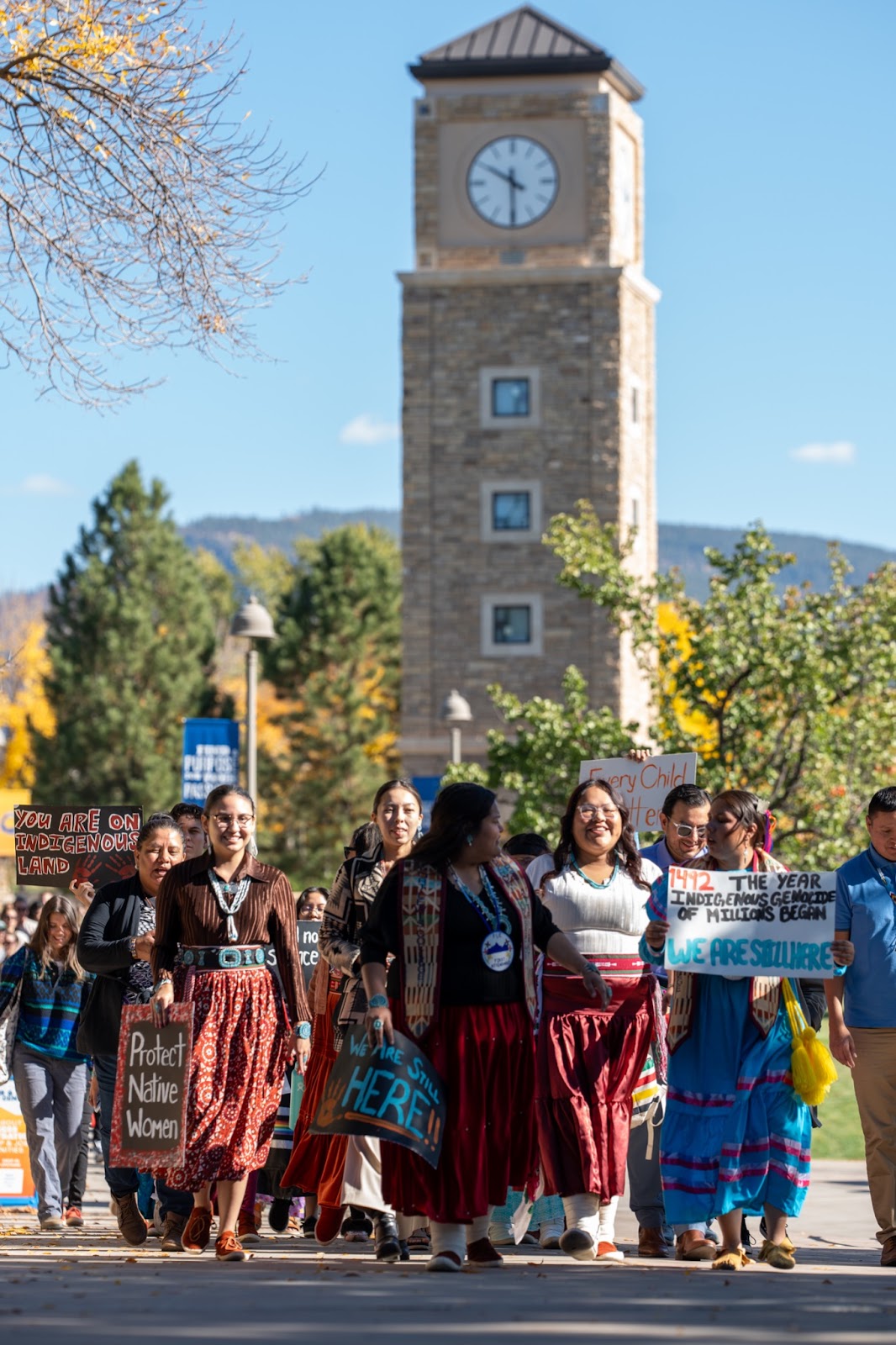
Students at the Fort Lewis College Indigenous Peoples’ Day Indigenous Blessing and Solidarity Walk on Oct. 9. Photo by Fort Lewis College.
Part II: The Road to Resilience
Two days after the Oct. 3rd report was released, FLC’s Wellness Pear Advisory Council hosted an event in the Vallecito Room, which was temporarily dubbed the “Resilience Room,” as a space for the community to reflect, to relax and to heal.
There were snacks stacked neatly on two tables by the entrance, and calming music played over a video of a small cabin in the woods. Six tables had small QR codes that were direct links to the report.
In the back of the room stood two whiteboards, each posing a different question. One asked the students of FLC what they thought should be done in light of the information that was revealed in the History Colorado report. The other asked them about what they thought the most important steps the school should take next to educate the student body, acknowledge the harm dealt to Native Americans, and heal together. Students who attended the event were given sticky notes to jot down their answers, which they then stuck to the boards.
After the Resilience Room event ended, both whiteboards were wheeled to the front of the Student Involvement Center for all of the FLC community to see and read as they passed by.
On a similar note, the FLC Diné Club hosted its annual celebration of culture in the FLC Native American Center, which is the embodiment of what resilience looks like for Native Americans today.
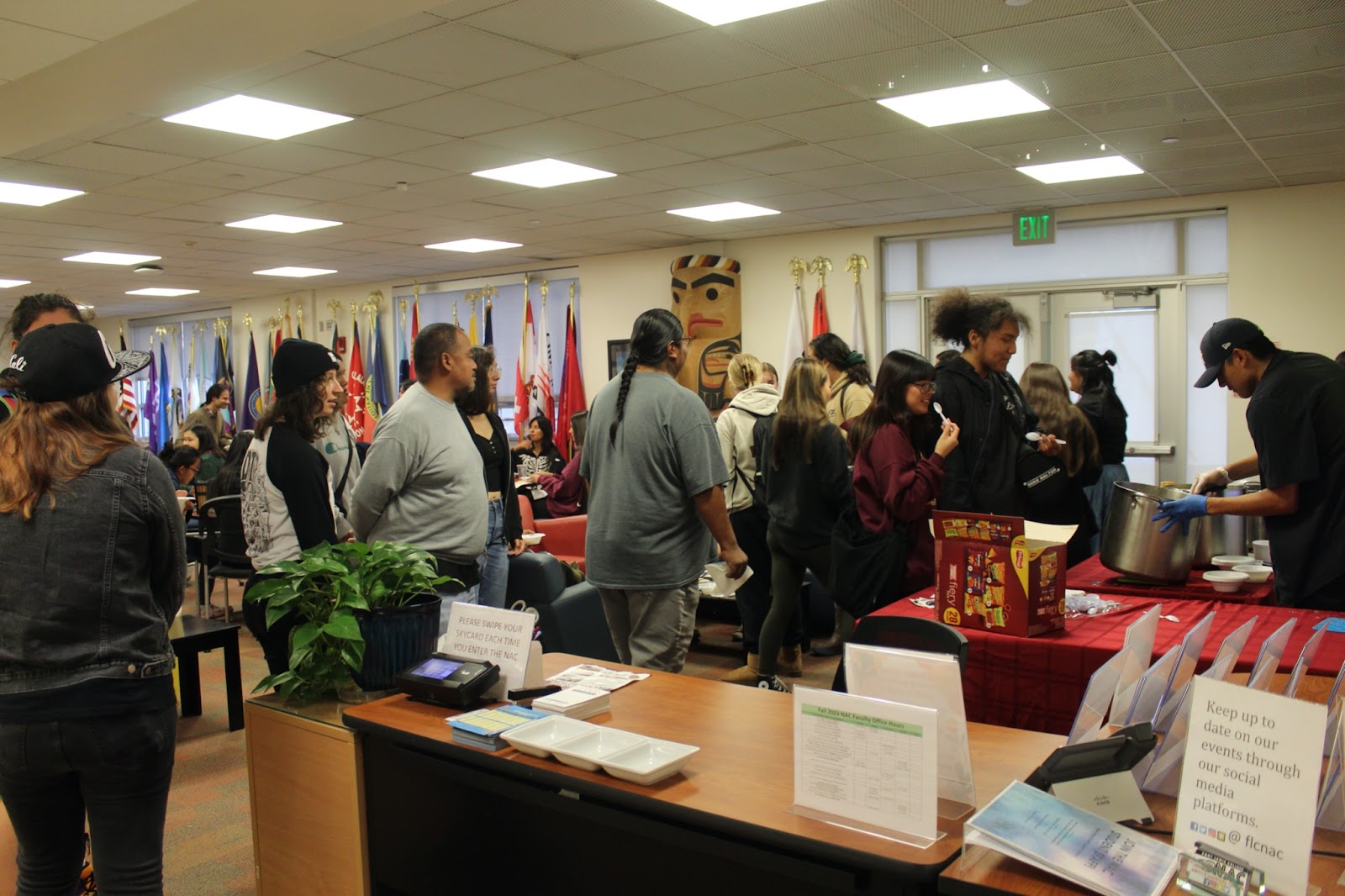
People gather in the Native American Center for the Diné Club’s annual celebration of culture event. Photo by Kiiyahno Edgewater.
Shenay Atene, an FLC student studying psychology and Native American Indigenous studies and president of the Diné Club, said that this was the second time the Diné Club hosted an event like this, which was meant to be a chance for students to come together, decompress and heal after the report came out. And one of the easiest ways to do that, she said, was through food.
“It happened last year after the death of our fellow FLC students, and it happened because we wanted to show students that we’re here—that we’re here to support them, even though we’re a small part of campus,” Atene said.
Atene said that a simple way to support Native students on campus is to bring a sense of home to them. Since the report came out in the middle of the semester, many students were unable to travel home and spend time with their loved ones. So, Atene said, the Diné Club decided to bring home to FLC.
“It’s just to kind of build community within Fort Lewis College,” Atene said. “We have a lot of Navajo students, and a lot of Southwestern students from surrounding tribes, so they’re very familiar with our food. We’re here for everyone, and we just want to build our community up. We want to be the positive in the midst of all this chaos right now, because I know a lot of students are feeling homesick.”
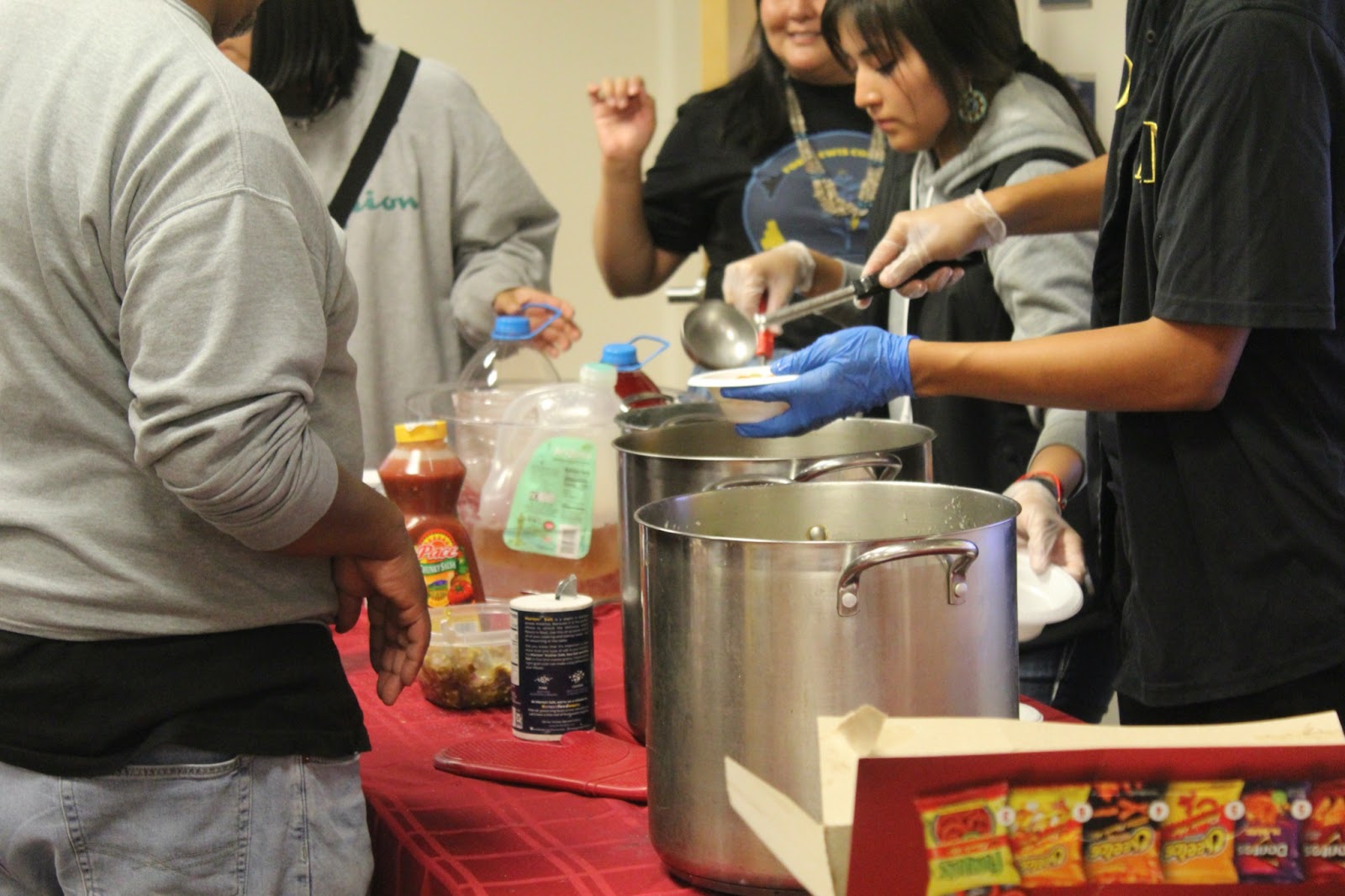
Diné Club members serve Native-inspired food. Photo by Kiiyahno Edgewater.
Apart from being a space for healing, the WellPAC event was also meant to kindle a sense of pride in Native culture, gather thoughts about the report and to cultivate hope for the future.
“I guess this is the part where we would say ‘you’re planting your seeds right now, and when you plant your seeds, what’s going to come from all this hard work and all this planning and preparation is what’s going to come in the spring,” Atene said. “It represents, for our Diné culture, a renewal. It’s this part of the planning stages are coming, getting prepared for that. It’s a time when the harvest is a time of abundance, a time for getting the benefits of all your work.”
In addition to outlets like the Diné Club event, FLC has made it known that therapy sessions are free to any student at FLC’s Counseling Center. But the type of counseling that FLC offers utilizes western psychotherapy techniques, which stem primarily from European and U.S. psychologists.
Selena Gonzales, a Diné student and secretary of the Pueblo Alliance, said that many Native students aren’t comfortable going to the Counseling Center for help, mainly because western psychotherapy techniques don’t adequately cater to their cultures.
“I think I would like to see more resources for Indigenous students,” Gonzales said. “I personally have tried therapy here. And I found out that westernized therapy is not for me. The only thing that works for me is my traditional and spiritual things. And it's not like there's a lot of spaces for us to do it here, either. I mean, there's the teepee grounds. But that's it.”
Gonzales said that while FLC is starting to make headway with giving Native students more space on campus to practice their culture, such as planning to build an Indigenous garden, they still have a ways to go.
“I think there's a space that we need to go to,” said Gonzales. “I mean, we can smudge, we can smoke tobacco, but we can't really do that in the dorms. We can't do that outside on campus a whole lot, because people will see it, and we could get in trouble for it. I think they need to focus on more Indigenous space resources,”
“Not every student is going to utilize counseling, or may feel like they need to utilize counseling, but we want to make sure we have those resources available,” Shotton said.
Today, 185 Tribes and Alaska Native Villages are represented at FLC. And while the school has made more efforts to pay homage to Indigenous cultures, many members of the community are advocating for the school to do more.
Stritikus said that he and the school were open to suggestions for what more they could do to help Native students.
“I want students to know that we're going to continue to listen to them and and work on active listening and together constructing what happens next,” Stritikus said
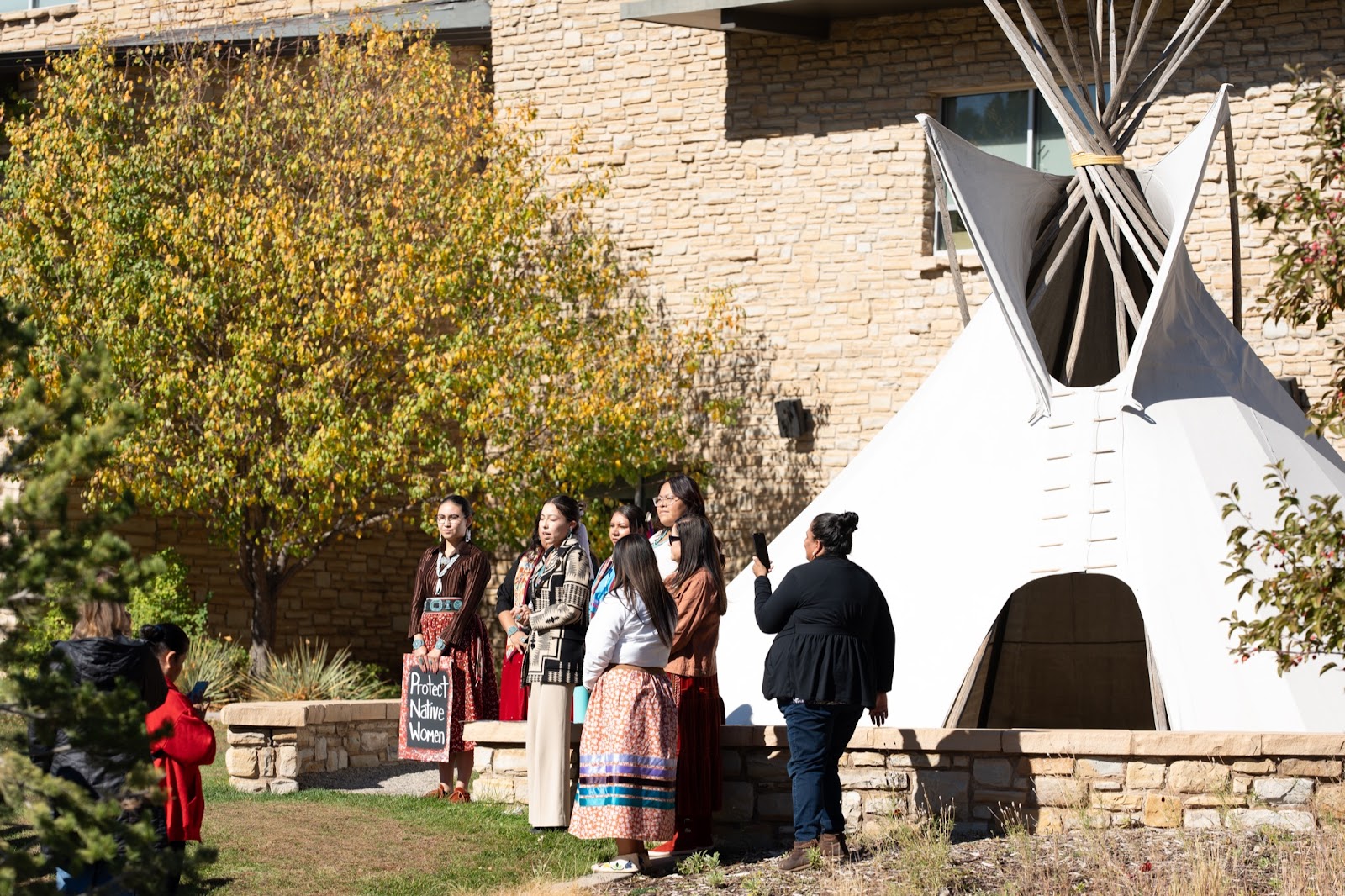
Brittany Bitsilly addresses a crowd at the Teepee Grounds during the Solidarity March on Oct. 9. Photo by Fort Lewis College. “ I just wasn't aware of how many Navajos attended the boarding school, which I think is the biggest thing that affected me with the report,” Selena Gonzales said.
Brittany Bitsilly, the president of the associated students of Fort Lewis College, said the response has been thoughtful and well-intentioned. However, she said, the school should continue to garner further student engagement, as it can be intimidating to speak at large events full of researchers, administration, and board members.
One recommendation Bistilly said was to create a digital discussion forum, where students could engage with each other about difficult topics through anonymity.
“It's important to garner those spaces of community where students feel that they can speak up about this, because it's a really deep and important issue,” Bitsilly said.
Misty Sandoval is a Diné student that attended the questions and answers event with Dr. Holly Norton held in the Vallecito room on Oct. 26. Additionally, Sandoval said, the school could be doing more to boost Native student involvement in the reconciliation process.
“I definitely feel like the school should get more students involved,” Sandoval said. “This could be doing honorariums or stuff like that just to help students feel like their voices are needed, and making sure that each and every one of our voices are heard, rather than like the faculty or staff or researchers who are doing all this work. I would like more students to get involved. So hopefully they push more to see how students can move forward and how they're coping with everything.”
While the college can make decisions at the administrative level, many students have taken action upon themselves to heal wounds and celebrate culture.
For Gonzales, that was spending time with friends and partaking in activities that connect her to her culture.
“I have gotten into beading again, which is nice,” Gonzales said. “I read and I spend a lot of time with my friends, because I find it really hard to be alone.“
For Sandoval, a large part of her healing process comes from recognizing that Native peoples are still here, flying in the face of the centuries-long efforts of the United States government to eradicate their cultures.
“There's generations behind us that were included within the boarding school era,” Sandoval said. “And so we think about their resilience, because we are all still here today. So what I cope with is just remembering that our strength comes in numbers.”
Part III: Looking Towards the Future
Clyde Benally, who is—among other admirable titles—a civil rights activist, Vietnam veteran, member of the Diné and FLC’s elder-in-residence, has been part of the FLC community for a long time.
Benally graduated from FLC in 1968 with a major in humanities, and as a first-year student, he was approached by FLC’s dean to help build the Shalako Club, an early incarnation of today’s Wanbli Ota student organization.
Benally created the Hozhoni Days powwow, a multi-day gathering of Indigenous groups from around the country, to celebrate Indigeneity through art, dance, song and food. The word “hozhoni'' translates roughly to English as “beauty,” he said, and this powwow has become FLC’s longest-running student-led tradition.

On the second day of the 56th annual powwow in 2022, dancers dressed in orange regalia to honor children who lost their lives away at boarding schools. Photo and caption by Tiarra Yazzie.
“I am the one that started Hozhoni Days, so I’ve been called ‘Father of Hozhoni days.’ One year they said I was the ‘grandfather of Hozhoni days,’” Benally chuckled. “When I came here, Native cultures were non-existent to a large extent. There is academia in our culture as well.”
In addition to Hozhoni Days, celebrations of Native culture at FLC also occur through various gatherings on campus.
“We host the annual Pueblo Feast Day on campus, which is super nice,” Gonzales said. “We have a bunch of Pueblo dance groups and singers, and we do keynote speakers. And there's a big dinner for everybody.”
“We even invite, like, Indigenous vendors, whether they're Pueblo or not,” Gonzales said. “You should always support Indigenous businesses.”
Carma Claw, FLC business professor and member of the Diné, said that being a Native person in business can be challenging. Claw said her experience in business was with companies mainly focused on profit, with lesser focus placed on community and future generations.
Claw believes the first step of healing begins with telling the truth. In reconciling with that truth, one of her missions is to expand the resources available for Native students pursuing a career in business, she said.
One resource for Indigenous business students is through the American Indigenous Business Leaders, or AIBL. Wraygen Shouldis, former president of AIBL, said the focus of the club is on equipping and empowering its members with the resources to succeed.
“Because we're such a close-knit and community-based culture, it's a very scary thing to be the only Native person in those positions,” she said.
Through AIBL, members are able to create a network for their future careers, and know that they have peers to lean on, Shouldis said. While AIBL is a business-oriented club, Shouldis said many other disciplines are present, such as engineering and public health majors.
“I'm really proud to see students on campus that just really embrace who they are,” Claw said. “It makes me happy. To me, celebrating who we are is just simply existing.”
In the Center of Southwest Studies, a new mural can be found on the staircase near the southern entrance. The mural, titled “Indigenous Futurity,” shows a vibrant depiction of Hesperus, a mountain sacred to the Navajo, which in their tradition is believed to be a source of power. CSWS also has a new exhibit titled “The Return of the Force,” celebrating the intersection between Indigenous culture and Star Wars.
FLC will never be able to undo its marred past. But, through the efforts of FLC’s staff, student body and Native activists, it may be able to become a better place in the future.
Matt Miguel, a Tohono O'odham and student senator , was asked to speak last at the CIRCL space event on Oct. 3rd.
“We cannot change the past of what has happened, we can't erase it,” Miguel said. “But what we can do is continue to move on, continue to persevere.”
Shotton echoed this sentiment. FLC can’t alter what happened in the past, but with continued efforts to recognize that while simultaneously striving to improve, FLC can continue to become a better place in the future.
“I think about when maybe your children are at Fort Lewis or my grandchildren are attending Fort Lewis, that Fort Lewis is still engaging in a process of reconciliation,” Shotton said.
“We're still here. I always tell my son that you're an expression of my grandmother's grandmother's grandmother, who said the first prayers that we read, that continue to exist,” Claw said.
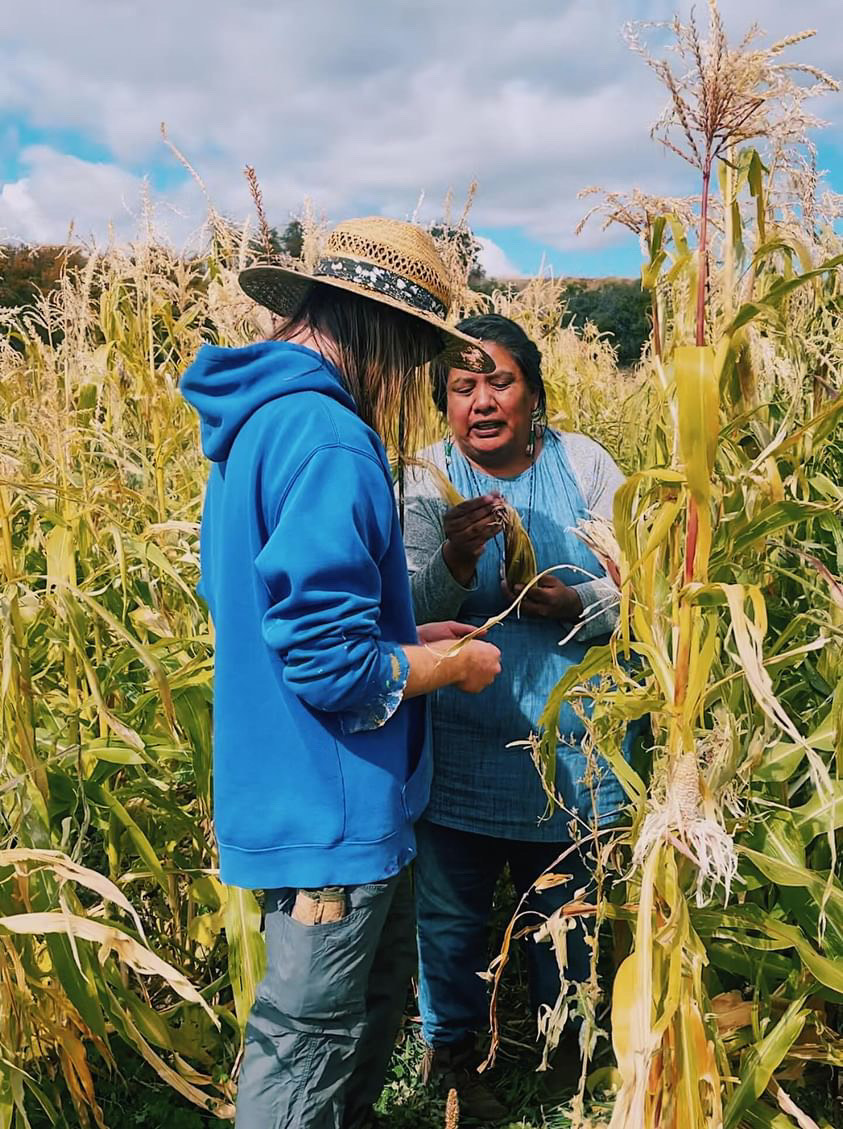
Karyn Denny educates an FLC student about blue corn during the Old Fort’s Oct. 13 blue corn harvest. Photo by Maddie Sanders.
On Oct. 13, Shotton attended the annual blue corn harvest at the Old Fort Farm. The farm, located at the site of the Fort Lewis boarding school, is now a place where FLC students can learn about agriculture in the desert Southwest—often employing the use of Indigenous agriculture techniques. For Shotton, this blue corn harvest was particularly special.

A student in regalia at the Oct. 13 blue corn harvest. Photo by Maddie Sanders.
“In the morning, they had a Ute elder there to provide a blessing for the harvest, and then they had different events throughout the day,” Shotton said. “Part of that was having some folks come and share stories, traditional stories about planting and harvesting and corn and sharing that knowledge, and there was a moment in there where everyone was asked to introduce themselves. And hearing so many of our Indigenous students who were at that event introduce themselves in their own tribal languages, was just so inspiring”
For so many Native students to have been able to attend this event and to celebrate their identity, at the same place where Indigeneity was once brutally punished, was profound.
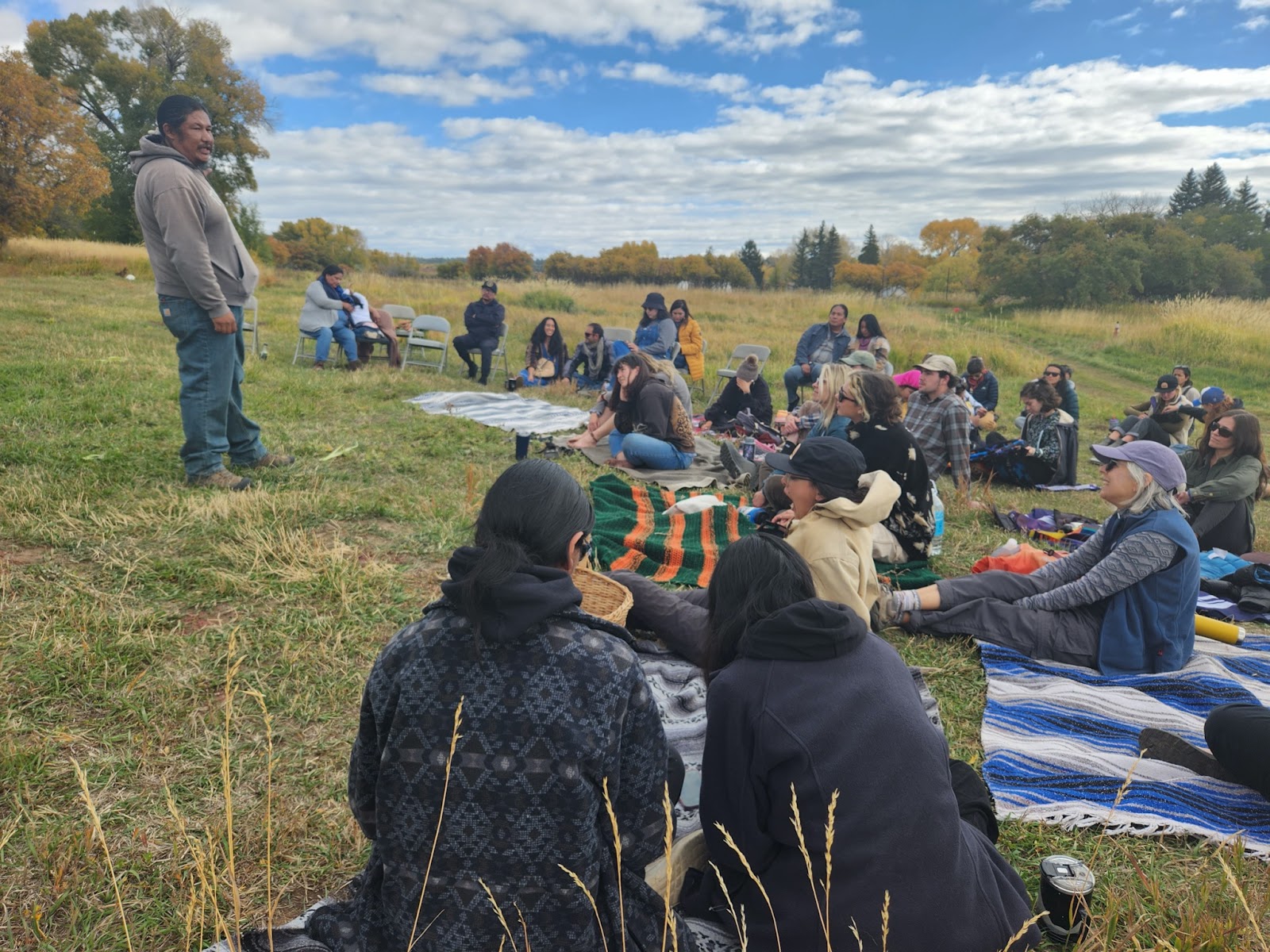
Students attending listen to a Ute elder at the blue corn harvest at the Old Fort on Oct. 13. Photo by Elicia Whittlesey.
“It's powerful that this space, at one time in history, the children and the students who were there wouldn't have been allowed to speak their language, and to see that, to hear and witness students reclaiming,” she said. “It was a really powerful moment.”
The beauty of Indigenous cultures has returned to Fort Lewis since the boarding school days. According to FLC’s Foundations of Diné Language Class professor, Dr Kari Deswood, many Diné prayers end by saying “hózhó náhásdlíí” four times to the four sacred directions. The phrase translates to English as “beauty has returned.”
Hózhó náhásdlíí
Hózhó náhásdlíí
Hózhó náhásdlíí
Hózhó náhásdlíí